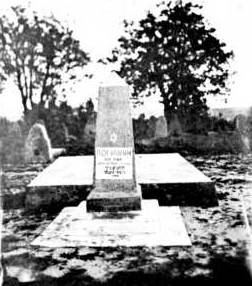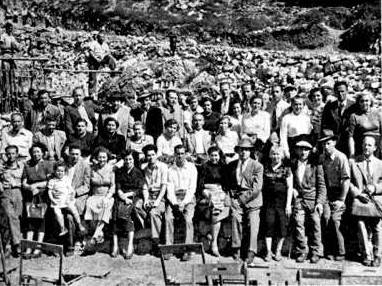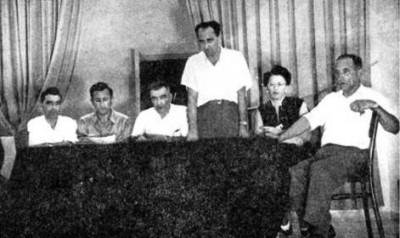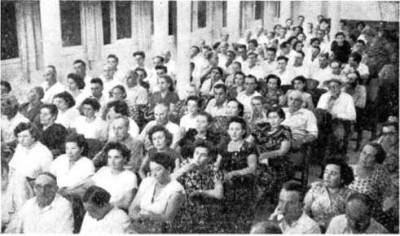[Page 449]

Communal Grave Of Our Martyrs Slaughtered By The Nazis
Cemetery In Rokitno
Gravestone reads in Russian and Hebrew:
“Killed By Hitler's Murderers 1942”
Translated by Ala Gamulka
My eyes have witnessed the bereavement
And my twisted heart is filled with outcries
My inner compassion has always led me to forgive
Until the times came that would not allow me to forgive
I then made an oath: to remember everything
To remember and never to forget.
Never to forget – up to the tenth generation,
Until my sorrow will subside, until they all will be gone,
Until all chastisement will end.
Mourning is in vain if the angry night passes
Mourning, if in the morning I return to my ways
And I will learn nothing again.
Avraham Shlonsky
[Page 453]
Association of Former Residents of Rokitno
and its Vicinity in Israel
History of the organization and its activities
The Executive Committee
Translated by Ala Gamulka
Until the second half of 1944 we did not know the fate of the Jews or of Rokitno and its surroundings. We did know that the well-known Bundist activist Shmuel Mordechai Zigelboim committed suicide on May 1, 1943, on the threshold of the British Parliament building in London. It was a protest against the disinterest the free world was showing about the murder of a whole nation. However, we did not imagine and we did not want to believe that it was actually extermination.
The person who did tell us this horrifying news, that the Rokitno community no longer existed, was our own Baruch Shehori (Schwartzblat). In 1944, he sent a postcard to his sister Sarah in Palestine. The postcard contained the following:
“Rokitno is alone and in mourning. More than half of it is in ruins. Many Jewish houses were erased off the face of the earth together with their owners. Eighty-three Jews came out of the forests and have gathered here. This is the remnant of a Jewish population of 1630 who were on the killing-field. There is now a small group of sick, poor, broken and dejected.”
This letter erased any false hopes and presented the sad truth to us. We were orphans. The letter was printed then in the local press and even in other countries. It touched many people. We toyed with the hope that “maybe, after all” someone remained alive. Many wrote letters to Shehori to ask about the fate of their relatives. He had no answer for them. His only reply was: “There is no one left of your family. They were all exterminated”.
This terrible news roused us to rescue the remnants from hunger and deterioration. This required proper organization. One Shabbat in 1944 the following members gathered in the Kupat Holim building on Ben Ami street in Tel Aviv: Yosef Eisenberg, Meri Burd, Dov Vorona, Hanan Hatzuvi (Trigun), Aharon Heruti (Freierman), Baruch Levin, Z”L, Yeshayahu Meiri (Meirson), Rachel Margalit (Meirson), and Haim Shteinman. It was decided to set up an organization of former residents of our town and its surroundings.
We began by collecting addresses of former residents of our town and its surroundings residing in the country in order to organize them in an institutional framework. This was not enough for us and we immediately began assistance activities. We sent packages of clothes and food to the survivors in Rokitno. The packages arrived and were used to save lives and were also a source of encouragement.
These activities were not continuous. Five years passed, during which we continued to collect addresses and to search for former residents. The first survivors, who came illegally to Eretz Israel, testified about the terrible destruction and this urged us to organize properly.
In 1949 we began in earnest (up to then we met as a small group). On the 13th of Elul (9/7/1949) we held the first gathering and the first memorial service in Tel Aviv. Many former residents of our town and its surroundings came from all parts of the country – from cities, settlements and kibbutzim. At this gathering survivors spoke about the terrible destruction. It was decided to establish the organization and the first executive committee was elected. It consisted of the following: Dov Vorona, Aharon Heruti (Freierman), Baruch Levin, Z”L, Aharon Lifshitz, Betzalel Kek, Baruch Shehori (Schwartzblat) and Haim Shteinman. The chairman was Haim Shteinman.
On 8 Tevet (12/28/1949) the first newsletter was sent to all former residents. The formation of this organization and its purpose were announced. The need to commemorate our martyrs who were exterminated in the Holocaust was emphasized. We attached a questionnaire and sent it to all those whose addresses we had. We asked them to pass the questionnaire on to others whose addresses we did not have.
In order to finance the activities of the organization we asked each member to pay one pound per year. We opened an account at the Bank of Savings and Loans in Tel Aviv. The response was good and we began our work. Haim Shteinman, who organized all activities, worked diligently and the organization functioned smoothly.
At the first meeting of the executive it was agreed that the first and foremost item was the commemoration of our martyrs. Accordingly, a newsletter was issued on 8 Tammuz (6/20/1950) in which we explained and emphasized the importance of commemorating our martyrs in a memorial book. We wanted to find appropriate material that pertained to Rokitno and its surroundings.
During all this time we never forgot our martyrs and we met every year to commemorate them. Eight years after the annihilation of Rokitno and its surroundings, a large gathering was held. We had managed to reach many of our former residents. At this gathering our member Aharon Heruti (Freierman) expressed, in a few sentences, our great pain and our terrible loss. Among the rest, he said:
“Today represents eight years since the Jews of our town and its surroundings were murdered. On 13th Elul, eight years ago, our dearly beloved parents, brothers and sisters were called to the market square and they did not return. We meet today, as we have every year, to remember all those who were so dear to us. We are left with wonderful memories. These are memories of Rokitno and its surroundings where we spent our best years, where we dreamed of Zion and our capital Jerusalem. Our beloved memories are full of sorrow because this beautiful world was annihilated and became a pile of bones.”
He was followed by Baruch Shehori (Schwartzblat) who spoke about Rokitno during the Soviet occupation at the outbreak of the Holocaust. When he finished, Baruch Levin, Z”L, reminisced about the vibrant life in Rokitno in the past and he eulogized the fallen. Haim Shteinman discussed the administrative activities of the organization. He announced that the assistance to the survivors in Rokitno was over since they had all left Rokitno, either to Israel or overseas.
At this memorial service, the first national executive committee was elected. The following were its members: Ziporah Blizhovsky, Zvi Barzilay (Eizenstein), Yitzhak Golod, Dina Vardy (Roitblat), Dov Vorona, Aharon Heruti (Freierman), Baruch Levin, Z”L, Aharon Lifshitz, Yeshayahu Meiri (Meirson), Yitzhak Freger, Israel Kek, Baruch Shehori (Schwartzblat), Haim Shteinman, Zvi Shapira, Z”L.
The committee slowly broadened its sphere of activities. On 6/29/1952 we gathered all former residents living in the north in order to tighten our contacts. The meeting took place in the hall of Mitbah Hapoelim on Hechalutz Street in Haifa. There was lively participation. At this gathering, Haim Shteinman spoke representing the committee, about its activities, plans for the future and preparations for the tenth anniversary of the extermination of Rokitno and the surrounding communities.
When the survivors arrived in the country, some of them turned to the organization for financial help. We saw the need to have a fund for assistance and Gmilut Hassadim. It was begun in 1951. The following members formed the committee: Shlomo Blizhovsky (Chairman), Aharon Heruti (Freierman), Aharon Lifshitz, Haim Shteinman, Zvi Shapira, Z”L. Some former residents who had means contributed large sums of money to this fund. The fund was very helpful to those who were needy. The loans were small, but they saved the recipients. They, in turn, knew how to appreciate the value of the fund. After it was decided to produce a memorial book, the fund was closed and any remaining money was transferred towards this project.
Our first commemorative activity was the planting of a grove of trees (with the help of the Jewish National Fund) in memory of the fallen from Rokitno and surroundings in the Martyrs Forest (Forest of Poland) in the hills of Jerusalem.
This activity necessitated intensive organizational work. On 29 Kislev (12/17/1952) a special newsletter was issued to all our former residents to announce the project. We attached a questionnaire in which we asked for the number of people that each family wished to commemorate and any other details.

Participants In Planting Ceremony In Martyrs Forest In 1952
First row from top, right to left: 1… 2… 3. Ziporah Fishman 4. Rivka Kutz 5. Nachman Fishman 6. Avraham Tendler 7. Henia Tochman 8. Yosef Vorona 9. Greber 10. Nachman Vorona 11. P. Lichtman 12. Brach 13… 14. Avraham Eisenberg 15. Yosef Eisenberg 16. Nachman Vorona 17. Haim Shteinman
Second row, right to left: 1. Freiman 2. Aharon Freiman 3. Fania Freiman
4. Naiberg 5. Shoshana Shteinman 6. Breindl Tendler 7. Vorona
Third row, right to left: 1. Ephraim Vorona 2. Dov Vorona 3. P. Fuchsman
4. Sara Fuchsman 5. Ziporah Blizhovsky 7. Natan Levin 8. Grinshpan 9......
10. .....11. Hagai Baum 12. Turovitz 13. Dov Baum
After we went over the questionnaires we discovered that, for now, there would be 600 trees. We hoped, in the future, to reach the goal of 1000 trees. In cooperation with the Jewish National Fund the first planting was held on Tu B'Shevat (1953). We invited our members to the ceremony. Many arrived from all parts of the country and planted the first seedlings with their own hands in the area assigned to us. A sign was placed reading “Grove of the Martyrs of Rokitno and Surroundings”. We stood together to memorialize our martyrs and our members. Yeshayahu Meiri (Meirson) and Haim Shteinman eulogized our dearly beloved with emotional speeches.
The planting of the grove occurred ten years after the extermination of the community of Rokitno and surroundings. That year we held a memorial assembly, with many participants, in the hall of the Educational Center on Raines Street in Tel Aviv. Haim Shteinman presided over the assembly. Baruch Levin, Z”L, concentrated on discussing the ten years since the extermination. Baruch Shehori (Schwartzblat) reminisced about the Holocaust period and the announcer Shamai Rozenblum (survivor of Lodz ghetto) read chapters on the Holocaust. Haim Shteinman reported on the activities of the executive committee and on plans for the future. Aryeh (Liova) Geipman reported on the Gmilut Hassadim fund. At that assembly we distributed certificates provided by the Jewish National Fund to those who had planted trees. At the end a film was shown.

Presiding Committee At The Memorial Assembly In Tel Aviv
Commemorating The Tenth Anniversary Of The Destruction Of Rokitno And Area
Right to left: 1. Aryeh (Liova) Geipman 2. Dina Vardy (Roitblat) 3. Baruch Levin, z”l - speaking 4. Zvi Shapira, z”l 5. Haim Shteinman 6. Aharon Lifshitz
On 13th Elul (9/9/1957), a memorial assembly was held to commemorate the 15
th anniversary of the extermination in the new hall of “Our Home” in Haifa. Among other remarks, Haim Shteinman said the following:
“We have gathered here tonight to remember a Jewish town and its surrounding area which have been annihilated forever. Let us together commemorate our dearly beloved. We will view the images of mothers and fathers, brothers and sisters, who were slaughtered by the Nazi beasts and their Ukrainian helpers. In our minds we see the market square, surrounded by killers, where our town members were brought helpless.
We see the ditches full of bodies, the fields full of the spilled blood of our dearly beloved and their unmarked graves. A cruel fate unites them in their deaths there and their memories are with us here. Let us pray tonight, in their memory, a special prayer.”

The Audience At The Memorial Assembly Commemorating The
Tenth Anniversary Of The Destruction Of Rokitno And Area
After this opening statement, Haim Shteinman gave over the chairmanship to Yaakov Rotman. The latter said:
“On this day, 15 years ago, we were all orphaned. Today is the memorial day for them. We, the few survivors of the community of Rokitno and surroundings, lit an eternal light near the memorial board commemorating our community on Mount Zion in Jerusalem.
We will also light 15 candles in memory of that day. We will pray the evening prayer and we will recite Kaddish together.”
One of the survivors from Rokitno who had just come from there, told us about the present look of our town. Then the girls Ronit Shabad and Edna Barman (both from our town) did special readings. This was followed by a report of the activities of the organization.
This material is made available by JewishGen, Inc.
and the Yizkor Book Project for the purpose of
fulfilling our
mission of disseminating information about the Holocaust and
destroyed Jewish communities.
This material may not be copied,
sold or bartered without JewishGen, Inc.'s permission. Rights may be
reserved by the copyright holder.
JewishGen, Inc. makes no representations regarding the accuracy of
the translation. The reader may wish to refer to the original material
for verification.
JewishGen is not responsible for inaccuracies or omissions in the original work and cannot rewrite or edit the text to correct inaccuracies and/or omissions.
Our mission is to produce a translation of the original work and we cannot verify the accuracy of statements or alter facts cited.
 Rokitnoye, Ukraine
Rokitnoye, Ukraine  Yizkor Book Project
Yizkor Book Project
 JewishGen Home Page
JewishGen Home Page
Yizkor Book Director, Lance Ackerfeld
This web page created by Lance Ackerfeld
Copyright © 1999-2024 by JewishGen, Inc.
Updated 16 Nov 2002 by LA





 Rokitnoye, Ukraine
Rokitnoye, Ukraine  Yizkor Book Project
Yizkor Book Project
 JewishGen Home Page
JewishGen Home Page